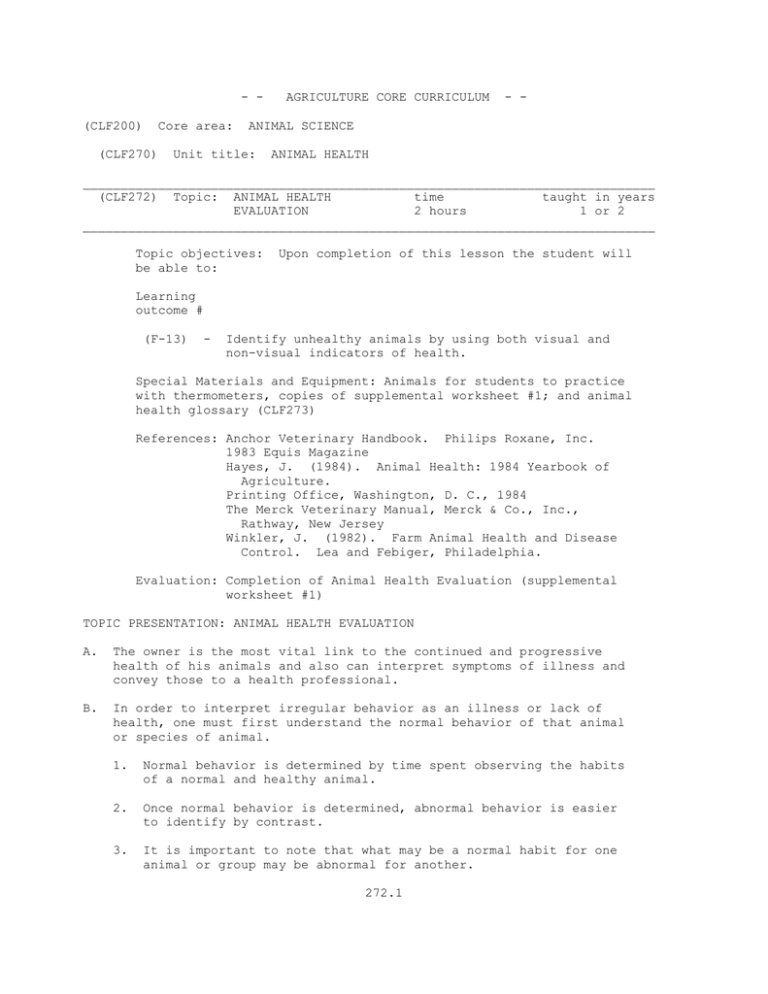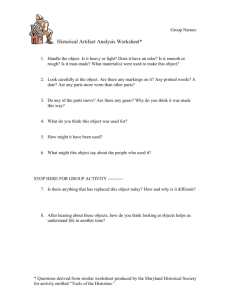CLF272
advertisement

- (CLF200) Core area: (CLF270) AGRICULTURE CORE CURRICULUM - - ANIMAL SCIENCE Unit title: ANIMAL HEALTH ____________________________________________________________________________ (CLF272) Topic: ANIMAL HEALTH time taught in years EVALUATION 2 hours 1 or 2 ____________________________________________________________________________ Topic objectives: be able to: Upon completion of this lesson the student will Learning outcome # (F-13) - Identify unhealthy animals by using both visual and non-visual indicators of health. Special Materials and Equipment: Animals for students to practice with thermometers, copies of supplemental worksheet #1; and animal health glossary (CLF273) References: Anchor Veterinary Handbook. Philips Roxane, Inc. 1983 Equis Magazine Hayes, J. (1984). Animal Health: 1984 Yearbook of Agriculture. Printing Office, Washington, D. C., 1984 The Merck Veterinary Manual, Merck & Co., Inc., Rathway, New Jersey Winkler, J. (1982). Farm Animal Health and Disease Control. Lea and Febiger, Philadelphia. Evaluation: Completion of Animal Health Evaluation (supplemental worksheet #1) TOPIC PRESENTATION: ANIMAL HEALTH EVALUATION A. The owner is the most vital link to the continued and progressive health of his animals and also can interpret symptoms of illness and convey those to a health professional. B. In order to interpret irregular behavior as an illness or lack of health, one must first understand the normal behavior of that animal or species of animal. 1. Normal behavior is determined by time spent observing the habits of a normal and healthy animal. 2. Once normal behavior is determined, abnormal behavior is easier to identify by contrast. 3. It is important to note that what may be a normal habit for one animal or group may be abnormal for another. 272.1 ___________________________________________________________ ACTIVITY: On-farm observation of animal behavior: Have students record behavior of normal animals. This can be done at home or on the school farm. It can be done with pets or livestock. They should observe the animal for 30-60 minutes. Have them report their observations and answer the question, was it "normal" behavior? ___________________________________________________________ C. A physical examination involves using all 5 senses: listening, touching, seeing, smelling and at times, tasting. 1. 2. Inspection at a distance should be done first, look at the animals: a. sleeping habits - time of day, standing, or lying; b. eating habits/nutritional state - time spent eating, time of day preferring to eat, meal eaten throughout day or all at once; c. attitude - gregarious, pecking order, social behavior, solitude d. posture - weight shifting from one foot or side; e. gait -is there indication of lameness; f. breathing - difficult, fast, slow; and g. physical condition - weight loss, hair coat, skin odor. Next restrain the animal and note (see also CLF274): a. temperature, b. heart rate c. respiratory rate (pulse) and ___________________________________________________________ ACTIVITY: ******************************************************* Before doing the following activity, please see CLF274, "Normal Temperature, Pulse and Respiration. ******************************************************* 272.2 Have the students take an animals temperature and heart rate. Ideally you should use some type of livestock, but in a pinch, a dog will do. Divide the students into pairs for this activity. Be sure to demonstrate proper techniques before allowing the students to try recording the temperature and heart rate. Supervise the activity carefully so no animals (or students) are stressed or injured. ___________________________________________________________ 3. 4. Then, begin a systematic examination of all major areas of the animal body, noting amount, color, turbidity, odor and consistency of discharges from any of the following body openings: a. nose, b. mouth, c. eyes, d. ears, e. uro-genital (excretory, genital), f. anus-- take samples of feces and urine if needed, and g. any wounds, scratches, abrasions. Continue to review external body surfaces; look for changes in color, size and shape indicating abnormalities. Evaluate the: a. status of hydration - does he look dehydrated; b. color of mucous membranes - which should be pink, not yellow or white; c. capillary refill time - should be quick (demonstrate this on your arm;) d. mouth/throat - too much saliva may indicate infection in mouth or inability to swallow, lack of saliva may indicate fever or colic, check for choking, coughing, drooling, gagging, vomiting, foul odor, difficulty swallowing; e. ears - no discharge, head should not be tilted (ask the students what does it --- hint: ear infection.) mean if the head is tilted?); f. ribs - bloat; labored breathing g. legs/feet-- lameness, stiffness, straining, any leg favored; h. genitals - swelling or rash; 272.3 5. i. hair coat/skin - parasites, abnormal roughness; j. swelling/lumps/wounds - wound discharge, ulcerations; k. position of the animal - is it down, unable to rise, uncoordinated l. temperature, does it have a fever -- dry muzzle, loss of appetite, thirst, constipation, indigestion; m. milk production - is it normal for this animal; and n. possibility of the animal being in pain - are there tender spots, or things the animal avoids doing that are abnormal? After a thorough review, the symptoms and clinical signs will serve to narrow and determine the source of the problem. An important symptom of any animal is PAIN and it should always be a major concern when evaluating.an animal's overall health. a. Pain can be indicated by an animal in many ways, including: 1) irritability, 2) avoidance of certain activities, 3) atypical fear, 4) demeanor - (not alert, hunched up, etc.), and 5) loss of appetite. ___________________________________________________________ ACTIVITY: Health evaluation: If possible bring animals to campus or take a field trip so students can do a health evaluation on an animal. Divide them into groups and use the Supplemental Worksheet #1 ___________________________________________________________ 272.4 Supplemental Worksheet #1 Name ___________________________ Date ___________________________ - - Animal Health Evaluation - A physical examination involves your use of all 5 senses: listening, touching, seeing, smelling and at times, tasting. 1. 2. 3. Inspection at a distance: a. sleeping habits ________________________________________________ b. eating habits/nutritional state ________________________________ c. attitude _______________________________________________________ d. posture ________________________________________________________ e. gait ___________________________________________________________ f. breathing ______________________________________________________ g. physical condition _____________________________________________ Restrain the animal and note: a. temperature ____________________________________________________ b. heart rate c. respiratory rate _______________________________________________ (pulse) ____________________________________________ Systematic examination of all major areas: a. nose ___________________________________________________________ b. mouth __________________________________________________________ c. eyes ___________________________________________________________ d. ears ___________________________________________________________ e. uro-genital area _______________________________________________ f. anus ___________________________________________________________ g. wounds, scratches, abrasions ___________________________________ 272.5 4. 5. Continue to review external body surfaces: a. status of hydration ____________________________________________ b. color of mucous membranes ______________________________________ d. capillary refill time __________________________________________ e. mouth/throat ___________________________________________________ f. ears ___________________________________________________________ g. ribs ___________________________________________________________ h. legs/feet ______________________________________________________ i. genitals _______________________________________________________ j. hair coat/skin _________________________________________________ k. swelling/lumps/wounds __________________________________________ l. position of the animal __________________________________________ m. indications of [possible] fever ________________________________ n. milk production (if applicable) ________________________________ o. indications of [possible] pain _________________________________ Other comments or observations _____________________________________ ____________________________________________________________________ ____________________________________________________________________ ____________________________________________________________________ ____________________________________________________________________ ____________________________________________________________________ ____________________________________________________________________ 272.6
